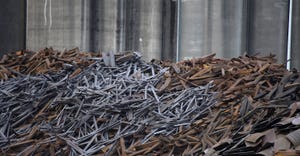How Green Was My Garbage Truck
May 1, 2011
Hauling is a public health industry, and recycling is a resource conservation industry. Yet they also are trucking industries, requiring large fleets to collect materials and transport them to transfer stations or processing facilities. In fact, the public and private sectors use more than 130,000 garbage and recycling trucks to collect these materials. A smaller number of larger, long-haul trucks are used to transport these materials to disposal sites or recycling facilities.
The reality is that the specialized equipment needed on garbage and recycling collection trucks makes them unusually heavy, even when empty. In addition, these heavy-duty, short haul trucks constantly stop and go while on their routes, burning fuel and gaining weight as they collect materials. As a result, they consume a lot of gas, averaging less than five miles per gallon. No wonder that haulers and recyclers have a great stake in making sure their trucks are as fuel efficient as possible.
Fortunately, the U.S. collection fleet has a relatively modest carbon footprint — well under one hundredth of a percent of all U.S. greenhouse gas emissions. In fact, garbage trucks were prominently mentioned as leading “green truck” candidates at the Green Truck Summit in Indianapolis in March. Several speakers noted that gasoline created from landfill gas has the biggest carbon-reducing impact of any biofuel. Others cited tests of hybrid trucks to collect garbage in New York City and the use of liquefied natural gas or compressed natural gas for refuse or recycling trucks. I have to admit, I enjoyed hearing that garbage and recycling trucks were good green candidates.
However, some speakers discussed the regulations proposed last winter by the Environmental Protection Agency and the National Highway Traffic Safety Administration to lower fuel consumption and emissions of greenhouse gases from medium- and heavy-duty trucks. If adopted as proposed, those regulations will create roadblocks for the green refuse packer due to the contradictory interplay of environmental and truck weight laws.
As I noted above, solid waste trucks are heavy when empty. When NSWMA submitted its response to the two agencies’ proposal in late winter, we noted that our industry has every desire to use less fuel and reduce greenhouse gas emissions. We also noted that the heavy empty weight of our trucks creates a significant problem under federal truck weight law.
Long-haul trucks and their contents can weigh 80,000 pounds. However, the shorter wheelbase of garbage and recycling trucks results in a much lower legal weight — usually around 51,000 pounds. Since these trucks weigh about 33,000 pounds empty, they have a legal payload of about nine tons. Garbage trucks usually hit the legal weight limit before they are full.
Our comments stressed that any extra “unproductive” equipment — no matter how worthwhile its purpose, whether it is to reduce fuel consumption, lower emissions or increase brake safety — adds to the empty weight of the truck and reduces the truck’s productive capacity. The proposed rule will add weight to the trucks, leading to the unintended consequence of putting more trucks on the road, consuming more fuel and creating more emissions.
Unfortunately, neither agency has any control over federal or state truck weight regulations. They will offer sympathy but are not likely to offer any relief in the final rule. I expect the recycling and solid waste industry will soon be seeking truck weight relief from Congress. I hope you join us.
You May Also Like


